2019
ND Gardner Winter Rye a New Release
Cover crop use is increasing rapidly not only in ND, their use is expanding across the country. Winter rye is one of the main species being used as a cover crop across the nation including ND. For Northern climates with shorter growing seasons, an early maturing rye variety is very important for cover cropping. This is especially true for use as a cover crop for soybean and dry bean production where rye is currently used as a cover crop to sow these cash crops into. The benefits of rye for weed and erosion control is greater when more biomass can be produced before the rye is terminated. An early variety is also very important for the roller crimper system that relies on early anthesis for termination. This system is being used by farmers across the Midwest and beyond. Winter rye is also being used a forage crop in ND along with double cropping it with other forage or grain crops. An early maturing rye variety will have many advantages for uses described.
The importance of plant breeding is to develop new lines with improved traits that are desirable for the intended end use. Very little effort has gone in to improving varieties with desirable traits for cover crop use as compared to what has occurred with breeding improvements in cash crops. Releasing a variety with traits desirable for cover crop applications will insure that farmers use good quality seed of known origin to obtain the desired benefits of the cover crop.
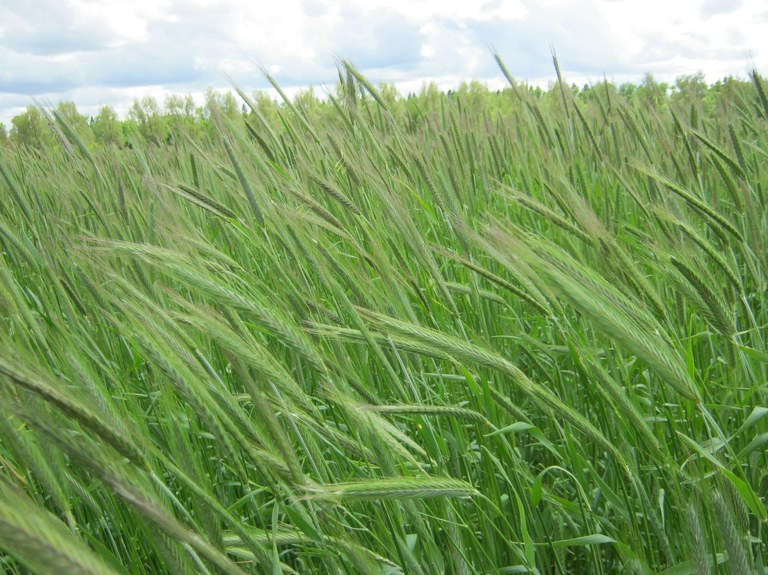 ND Gardner winter rye starting to flower.
ND Gardner winter rye starting to flower.
The CREC agronomy program coordinates the NDSU state winter rye variety testing program along with a diverse research program using rye as a grain, forage and cover crop. The CREC has also been working on variety development focusing on winter hardiness, early season vigor, and biomass production, and early maturity. Results of this work has led to a newly released variety. ND Gardner winter rye was developed and increased at the CREC and released by the North Dakota Agricultural Experiment Station with foundation seed distributed by the ND Crop Improvement and Seed Association for the 2019 fall planting.
ND Gardner is intended to be used mainly for the cover crop/forage market. It is intended to replace Aroostook, a variety developed by USDA in 1981. Aroostook is used extensively for cover crop applications. ND Gardner is also a candidate for forage use and could be a replacement for Wheeler rye, a variety released from the Michigan State University in 1971 for forage and green manure use. ND Gardner is a very early, tall variety with very good winter hardiness and good early season vigor. These attributes make it a good candidate for the rapidly growing cover crop market.
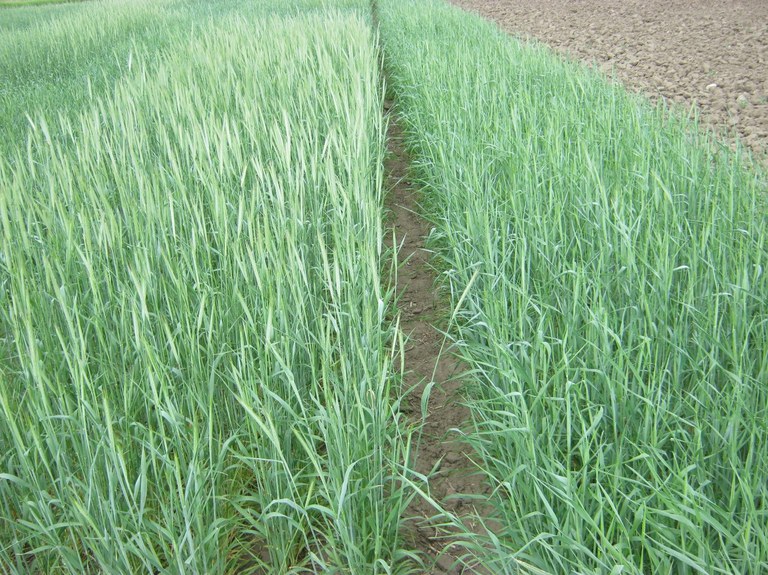 ND Gardner (left) alongside ND Dylan illustrating maturity differences between varieties.
ND Gardner (left) alongside ND Dylan illustrating maturity differences between varieties.
ND Gardner is named to honor the memory and contributions of Dr. John Gardner, former director at the NDSU Carrington Research Extension Center. John was a visionary leader in many aspects of agriculture, including cover crop research.
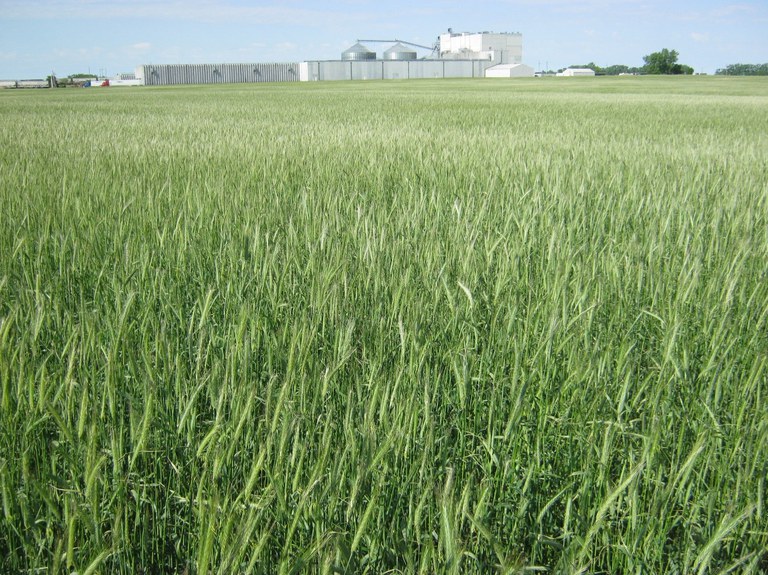 ND Gardner foundation seed field on June 12, 2019.
ND Gardner foundation seed field on June 12, 2019.
Steve Zwinger
Steve.Zwinger@ndsu.edu
Research Specialist/Agronomy
Happy Holidays
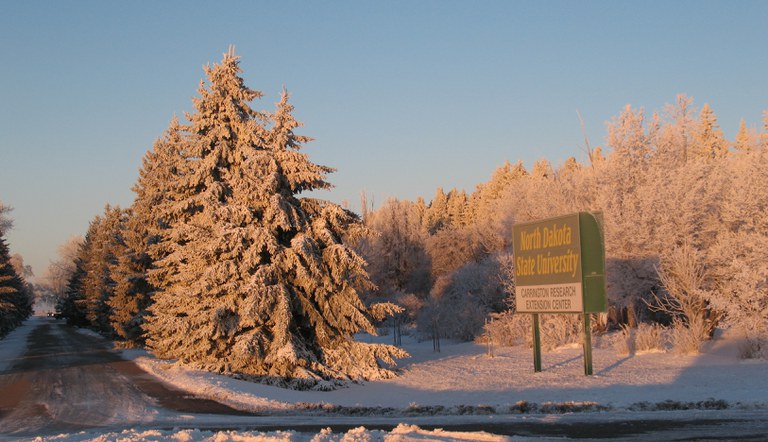
"Frosty Center Sunrise"
We wish you a Merry Christmas, Happy New Year and joy-filled 2019 holiday season!
From all of us at the NDSU Carrington Research Extension Center.
Is There Antagonism Between Glyphosate and Glufosinate?
In North Dakota we now have three crops where both glyphosate (ex RoundUp Powermax) and glufosinate (ex Liberty) can be applied in the same season. These crops are corn, soybeans, and canola. Since glyphosate is highly mobile in plants and glufosinate is a contact product, there is potential for antagonism on the plant surface. In 2018 we started to investigate the impact of adding glyphosate to glufosinate. In 2019 we tested combinations in three locations of ND with a variety of weed species. In each of these experiments we optimized the application for glufosinate (ex >15 GPA spray volume), which would be the recommendation. In 2019 we also tested combinations of glyphosate and glufosinate with Enlist One and Enlist Duo.
The weed species response varied. Shepard’s purse, common ragweed and redroot pigweed were controlled by all treatment combinations. Green foxtail control was initially good with all treatment combinations, however, by 21 days after application the presence of glufosinate caused a mild reduction in control compared to glyphosate alone. Yellow foxtail control was not affected by the combination of products, it was simply less in treatments without glyphosate. Kochia control was negatively impacted by the combination of products. This is the one case where both products applied alone performed better than the combination. In fact, when adding Enlist products, Enlist Duo was better without glufosinate than with. In all other cases Enlist Duo was a neutral or positive addition.
Wild buckwheat control was enhanced by the combination of the two products. When glufosinate was applied alone, it quickly burned the leaves of wild buckwheat, by the end of the trial the buckwheat had recovered. Glyphosate alone was very slow to control buckwheat, but by the end finished better than glufosinate. When the were added together it was the best of both worlds. The buckwheat was quickly burned back and by the end of the trial the combination performed better than either product alone. Glufosinate with Enlist Duo or Enlist One provided an even larger benefit to buckwheat control at 7 days after application, but was similar to glyphosate plus glufosinate by 21 days.
In short, there was less antagonism than expected when using these combinations, however, each weed species had a unique response to the products. These combinations may be highly effective when used to manage herbicide resistance, but scouting for escapes will be necessary. Generally these escapes were not detectible until 2 weeks following application.
Table 1. Weed species of interest while testing combinations of glyphosate, glufosinate, and Enlist.
Mike Ostlie, Ph. D.
Mike.Ostlie@ndsu.edu
Research Agronomist
Yield Response of Corn to N Under Dryland and Irrigated Conditions at Oakes, ND
Method
- Two nitrogen (N) studies were established to assess the effect of N rates on corn yields under dryland and irrigated conditions at Oakes in 2019.
- N Treatments were: 0, 40, 80, 120, 160, 200 lbs applied as urea, on the soil surface, before strip-tiling corn.
- Previous crop was soybeans. Variety was: REA 4B953-RIB.
- Soil N and SOM before fertilizer application were 24 lbs N and 4.1%, respectively at the dryland site.
- The soil N and SOM content at the irrigated site were 38 lbs and 2.5%, respectively.
- Dryland corn was seeded on May 16th and harvested on December 2nd.
- Irrigated corn was seeded on May 17th and harvested on November 26th.
Results
- Yields were greater at the irrigated site than at the dryland site (Figure 1).
- At the dryland site, yields ranged from 126 bushels without N applied to 195 bushels at 120 or 160 lbs N, for an average yield of 172 bu/ac.
- Under irrigation, yields ranged from 131 bushels, without N applied, to 271 bushels at 200 lbs N, for an average yield of 238 bu/ac.
- Under dryland conditions, a comparison between average yields (Table 1) showed that the yields produced from 80 lbs N were not different from the yields produced at higher N rates, but was significantly greater than yields at 40 lbs N or without applied N.
- Under irrigation, the average yield at 40 lbs N was not different from yields at higher N rates, but was not also different from the 0 lbs N.
- Based on the graphs, the 142 lbs N was estimated to produce maximize yield of 179 bushels under dryland. Under irrigation, estimated maximum yield was 256 bushels, if 165 lbs of N was applied.
- However, these estimated N fertilizer rates were not economic N rates to maximize yields. Nitrogen contribution from soil and N credit from soybeans likely contributed the high yields at lower N rates.
Conclusions
- Even though N fertilization improved yields significantly, N in soil before fertilization (38 lbs under irrigation, and 24 lbs under dryland) and N from soybean credit (about 40 lbs N), no more than 80 lbs N was necessary because of N contribution from soil and soybean credit.
- Like for any fertilizer input, improved yields do not always translate to economic gains.
- Therefore, farmers are always encouraged to make their fertilizer decisions not based solely on yield increases from fertilizer application, but very importantly, should consider the net returns considering cost of additional input beyond recommended rates.
Acknowledgement: Thank you to the North Dakota Corn Council for funding this research.
Jasper M Teboh, Ph. D.
Jasper.Teboh@ndsu.edu
Research Soil Scientist
Using CREC Fruit: A Cake for Comfort
Like most people, I often take my work home. But in my case, I take home CREC fruit to see how it processes so that I know when people ask me. I know that our newer black currant berries have a lot more pectin that our past varieties when made into jam. I know that even though I always dreamed of making red currant jelly, I don’t really like it. Even though some fresh Juneberries have less flavor, they still make great pie! Aronia berries are not great fresh but frozen berries are amazingly good in oatmeal, yogurt and banana bread. Grapes take 12-24 hours to turn into raisins! And while Honeycrisp apples last the longest, I know that Zestar apples make the tastiest dried apples.
Here is a recipe for a cake that I made for a recent meeting at CREC. It received many compliments:
Teddie's Apple Cake
3 cups peeled, cored and diced (1/2”) tart apples, like Honeycrisp
½ tsp grated lemon peel and some juice squeezed over the apples
1 ¼ cups vegetable oil
1 ½ cups sugar
3 eggs
3 cups flour (2c all-purpose, 1c whole wheat)
¾ tsp salt
1 tsp cinnamon
¼ tsp nutmeg
1 tsp baking soda
1 tsp vanilla
1 cup chopped nuts
½ cup raisins warmed in rum
(I used homemade Somerset Seedless raisins)
Preheat oven to 350 degrees. Butter and flour a 9-inch tube (Bundt) pan. Beat the oil and sugar together in a mixer (fitted with a paddle attachment) while assembling the remaining ingredients. After about 5 minutes, add the eggs and beat until the mixture is creamy.
Sift together 3 cups of flour, salt, cinnamon, nutmeg and baking soda. Stir into the batter. Add the vanilla, apples, nuts and raisins (plus liquid) and stir until combined.
Transfer the mixture to the prepared pan. Bake for about 1 hour and 15 minutes, or until a toothpick inserted in the center comes out clean. Cool in the pan before turning out. Serve at room temperature with whipped cream or vanilla ice cream, if desired.
**This really is a nice cake. It keeps for days and can be made several days in advance. I usually blanch at this amount of oil, but it is important. It keeps the cake moist but not soggy and allows the crust to stay firm. I took note of user comments and the above recipe reflects the changes I made.
The recipe and comments I used are behind a paywall, but this site has the exact original recipe: https://food52.com/recipes/19828-teddie-s-apple-cake
Enjoy using your harvest!
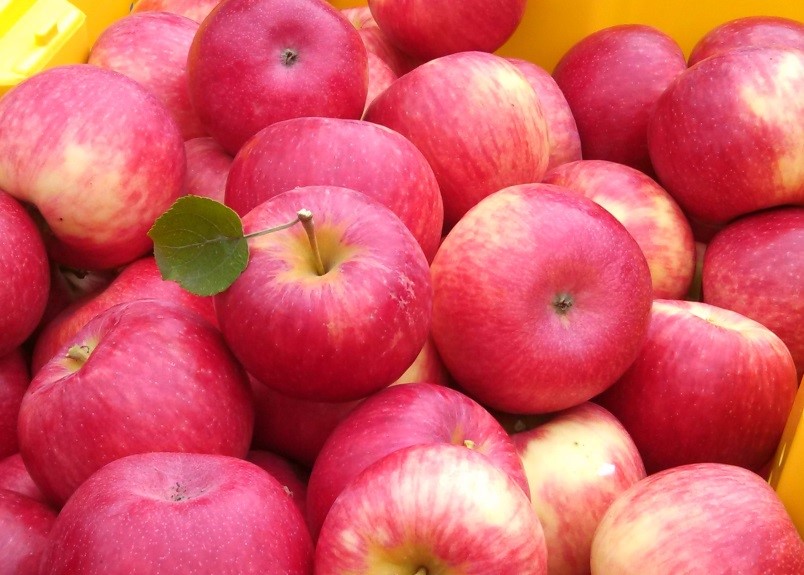
Harvested apples at the CREC from the Northern Hardy Fruit Evaluation Project.
Kathy Wiederholt
Kathy.wiederholt@ndsu.edu
CREC Fruit Project Manager
Benefits of Winter Trees
When we think of the benefits we enjoy from trees, it is likely we think of things derived during the growing season: green landscapes, shade, cleaner air, sequestration of carbon dioxide, and production of oxygen. But benefits of trees continue into the winter months, especially in places like North Dakota.
The use of trees for wind protection to reduce soil erosion has resulted in the planting of 55,000 miles of windbreaks, or shelterbelts, in North Dakota since the 1930’s. Strategic planting of trees and shrubs to form “living snow fences” can also effectively slow down, catch and channel snow in fields and off roads.
Trees cut down on dust and dirt particles entering a building and lower the loss of heat in buildings by reducing cold air infiltration. How much home heating energy can be saved? Even in urban areas, widely spaced trees break the force of chilling winds enough to save between 3 and 4 percent on heating bills. This translates to a national savings of $1.6 billion per year in single-family homes alone. Urban trees have a big impact on home energy use, no matter the season. And this includes not only the trees surrounding your home. Trees that are 2, 3 or even 6 blocks away from your home are impacting your home’s energy consumption. Even though trees are defoliated in the winter, they disrupt the air as the wind blows toward your house, which slows the wind down before it comes into contact with your walls. Twenty-five percent of home heat loss is due to wind and the related mechanically induced pressures, so reducing the wind that hits your home improves energy savings.
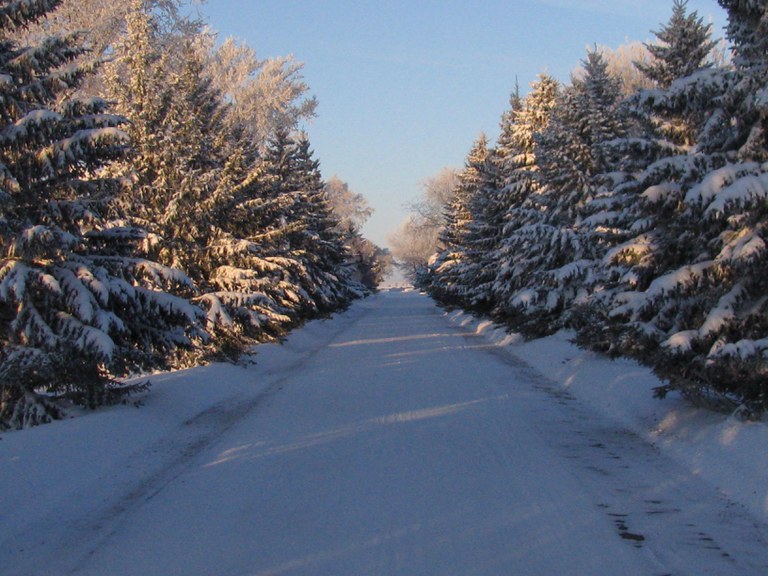
These trees at the CREC provide both beauty and protection during the winter.
Where should trees be placed for maximum energy savings? In urban plantings, don’t worry so much about placement to maximize your benefits – south to you is north to your neighbor. Conifers provide the best wind protection, but avoid planting evergreens where they block winter sun from warming the house. Observe summer shadows on your property to plan tree locations that will maximize energy saving benefits. Trees are year-round ecosystem services providers, and the more trees, the better.
Besides the practical benefits of trees, there is great beauty contributed by woody plants in the winter landscape. Trees and shrubs provide great cold-weather habitat for watchable wildlife. Colorful bark is characteristic of red-osier dogwood and cherry; exfoliating bark curls off the stems of river birch, Pekin lilac and Amur chokecherry. Persistent fruit hangs off the branches of ‘Red Splendor’ and ‘Prairifire’ crabapple, cranberrybush viburnum and mountain ash, providing food for winter birds. Red seed capsules of euonymus winterberry lend a real holiday view against a snowy background.
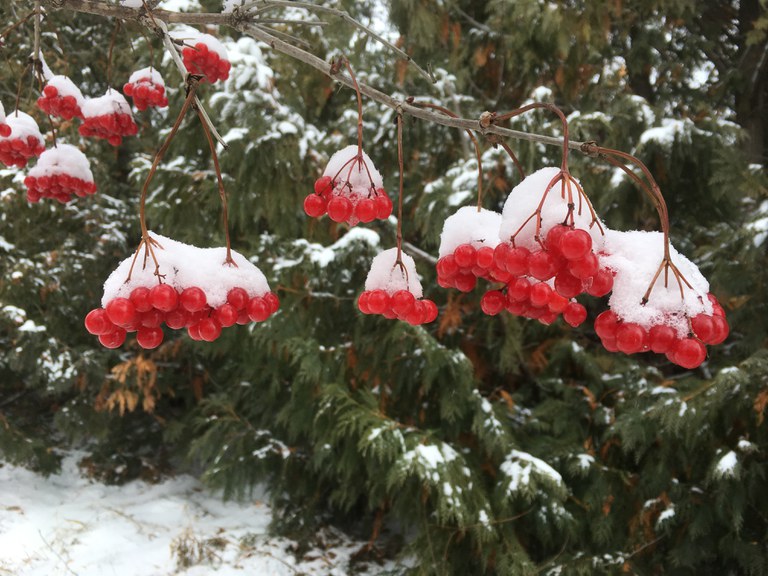
These berries provide food for winter birds at the CREC.
Whatever the latest forecast from NOAA (the National Oceanic and Atmospheric Administration) predicts for North Dakota, trees will help soften the blow.
Resources:
- Tree City USA Bulletin No. 21, “How Trees Can Save Energy”, www.arborday.org
- “Cold Climate Benefits from Trees”, www.deeproot.com
Gerri Makay
Gerri.Makay@ndsu.edu
ND Forest Service Community Forestry Program Manager
Overview of Dry Bean Variety Trial Results and Workshop
The NDSU Carrington Research Extension Center (CREC) has completed harvest of dry bean and soybean research trials and current work is with corn and sunflower. This article will provide an overview of the CREC’s dry bean variety trial results, plus announce a dry bean educational workshop series scheduled in January, 2020.
The CREC’s dry bean dryland and irrigated variety trials tested the performance of 29-30 varieties plus experimental lines among six market classes including pinto, black, navy, great northern, pink and small red. The dryland trial seed yield average was 25.1 cwt/acre and the irrigated trial averaged 34.0 cwt/acre. Other agronomic trial data includes days from planting to physiological maturity, scores for growth habit and direct harvest, seeds/lb and seed weight.
Seed yield (cwt/acre) of six pinto bean varieties averaged over three years at three sites (Carrington dryland and irrigated, and Oakes irrigated) for a total of nine site-years: LaPaz – 33.2, Monterrey – 32.1, Windbreaker – 31.1, Lariat – 30.5, ND Palomino – 30.4 and Stampede – 27.6. Among 17 pinto bean varieties tested in the CREC’s 2019 dryland and irrigated trials, varieties with yield averaging greater than 30.0 cwt/acre include Cowboy, LaPaz, ND Palomino, Radiant, Vibrant and Windbreaker.
Research results for the dry bean variety trials plus many other variety trials are available at the following website: www.ag.ndsu.edu/varietytrials/carrington-rec/2019-trial-results.
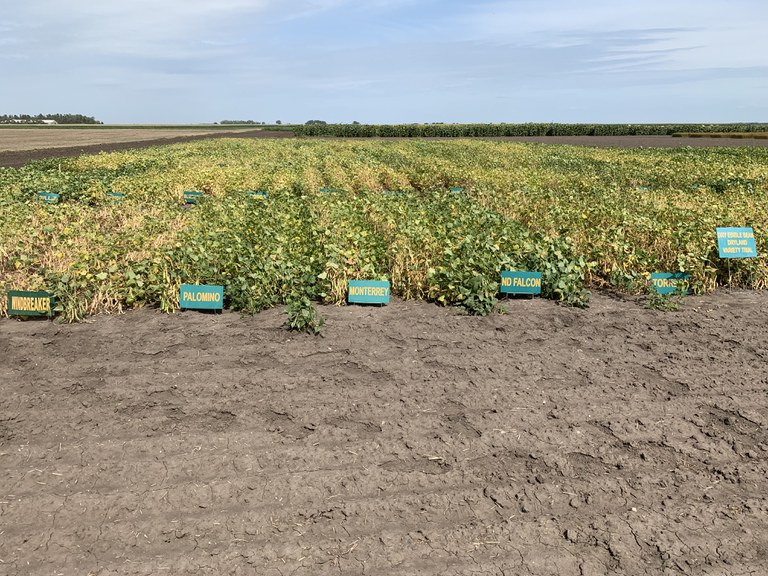
Dryland bean variety trial at the Carrington Research Extension Center.
A dry bean educational workshop series titled ‘Dry Bean Getting-it-Right’ will be conducted by NDSU Extension on January 30 in Park River and January 31 in Fessenden. Co-sponsor is the Northarvest Bean Growers Association. The workshop’s objective is to provide dry bean growers and crop advisers with NDSU’s newest research and recommendations to enhance the crop’s production and profitability. General subjects include plant establishment, nutrition and protection (disease, weed and insect management), and market update. Workshop details will be publicized when available.
Greg Endres
Gregory.Endres@ndsu.edu
Extension Agronomy Specialist
Don’t Graze Unharvested Soybean
Producers should not introduce hungry cattle to unharvested soybean fields. Ammonia toxicity is a threat to cattle that overconsume soybean. Whether it’s a pile of harvested soybean laying on the ground or an unharvested soybean field where cows have unlimited access. Eating too much soybean can lead to dead cattle.
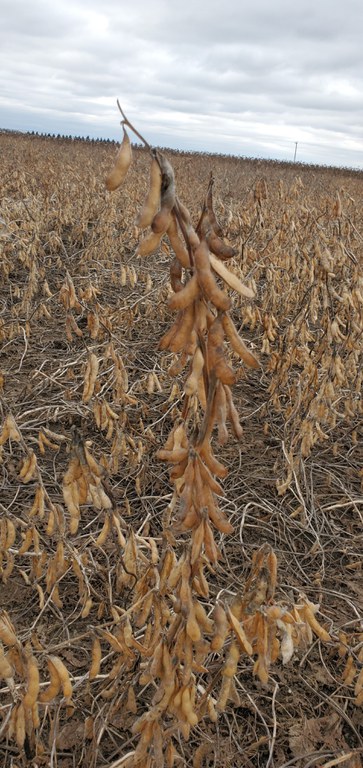
Unharvested soybean field.
Ammonia toxicity has been seen in cows that found a pile of harvested soybean and gorged themselves. With the large amount of whole soybean consumed and an active rumen, combined with the urease enzyme in soybean, this can lead to more ammonia production than the rumen microbes can normally utilize. Excess ammonia spills into the blood steam, causing death.
If you observe the toxicosis early enough, you can drench the cow with 1 to 2 gallons of vinegar (5% acetic acid) to change the ammonia to ammonium. The ammonium ion won’t leave the rumen and prevents the toxicosis. Unfortunately, most producers don’t find the animal soon enough and don’t have enough vinegar on hand to deal with an outbreak.
Cows can consume small amounts (2-4 pounds per day) of soybean as part of a balanced ration. This would provide additional protein to the ration. After 4 pounds of soybean in a mature cow ration, the oil content of the ration starts to interfere with digestion by the rumen microbes. When the oil content of the ration gets above 7% to 8%, then the oil becomes toxic to rumen microbes.
The unknown is what amount of soybean a cow will eat if she gets into an unharvested soybean field. If there is grass or corn stover, the cow might limit her soybean consumption while she is also eating the bean pod and stems. If she consumes too much soybean, ammonia toxicosis will lead to tremors, the cow will lay down, and die. Veterinary treatment is generally unsuccessful.
Karl Hoppe, Ph. D.
Karl.Hoppe@ndsu.edu
Livestock Systems Extension Specialist
Hard Conversations
A few weeks ago, my husband (Nick) and I invited some friends and family to spend the weekend with us at our farm celebrating our first anniversary. Fall suppers are my favorite with fresh potatoes, grilled meat, corn on the cob, cucumbers and tomatoes and our moms outdid themselves with a variety of desserts. We gathered in our quonset and after we were thoroughly stuffed, we played Cornhole, a few rounds of cards and ended the night just talking; swapping stories, sharing trials and offering advice. As Nick and I walked to the house late that night, we agreed how nice it was to know that our close friends and family members, who seem to have it all together, have the same life questions as us. “How long do we let our off-farm income support our farm?,” “Direct market our livestock or go to the sale barn?,” “Build a house now or wait a couple more years to see if we’ll be profitable here?,” “Pay for daycare and keep the job with insurance or keep the kids at home?,” “We’re buying used when everyone else is buying new, what’s the smarter investment?”…we don’t waste time with the weather when we get face-to-face time with our people. Granted, the weather has certainly been something to talk about this year.
It’s not nice to know that other folks are struggling, but it is nice to know that we’re not the only ones struggling. The point is, we spent nearly the whole summer having hard conversations between just the two of us and then find out after one night of visiting that we’ve all been asking the same questions and are having the same hard conversations.
That night didn’t fix anything, financially. We still don’t know if we should build our sheep flock or a house, buy a new pickup or a used tractor, or cash everything in and start over. But based on the conversations we’ve had with others since that night, we’re not the only ones wondering what to do right now with the current agriculture climate. Whether you have 10,000 acres or 10 acres, you run a research farm or you own a century farm, you grow wheat or you grow carrots, you raise cows or you raise hay, we’re all feeling the ramifications of the current situation we’re facing. Our situation is not more or less important than yours and yours is not more or less important than your neighbors. Just talking about what’s going on, even if it fixes nothing financially, can boost morale and diminish the severity of the issue. It takes the negative power away so we can logically reason.
So how do we start conversations with each other? A simple “How’s it going?” followed by active listening is a great step. If someone has stopped coming to coffee or cocktails, give them a call. If your usually-cheery social media friend stops posting, send them a text. If you haven’t seen your normally active neighbor, stop by and check in on them. Sometimes all it takes to change perspective is having someone listen to our hard conversations.
Following are some resources:
- Your local NDSU Extension agents are great listeners and have resources available to help: https://www.ag.ndsu.edu/extension/directory/counties
- Your local parishioners and clergy are also skilled listeners.
- There is a plethora of information on the NDSU Farm and Ranch Stress website: https://www.ag.ndsu.edu/farmranchstress including resources like these:
- 4 Steps to Managing Stress in Farming and Ranching (a set of reflective steps to assess needs and impacts, identify and access resources, pursue quality decisions, and connect with sources of support): https://www.ag.ndsu.edu/publications/kids-family/4-steps-to-managing-stress-in-farming-and-ranching
- Key Coping Tools in Times of Farm and Ranch Stress (a set of useful tools for your wellness toolbox in times of farm stress): https://www.ag.ndsu.edu/publications/kids-family/key-coping-tools-in-times-of-farm-ranch-stress
- Suicide Prevention Hotline 1-800-273-8255 (1-800-273-TALK). If you or someone you know is having thoughts of suicide, talk to someone. With help comes hope. Call any time. Answered locally by FirstLink.
- 2-1-1 FirstLink. Provides information online or by phone about helpful community and volunteer health and human services resources.
- FirstLink database of nonprofit agencies, health and human services agencies, and government resources: (http://myfirstlink.org/community-resources)
- Call the 2-1-1 Helpline for confidential listening and support, information, and referral.
- Substance Use Disorder Voucher Program. Receive financial help to access substance use disorder treatment and recovery services from participating providers if you qualify.
- Information is online at www.behavioralhealth.nd.gov/addiction/substance-use-disorder-voucher
- List of Participating Providers is online at www.nd.gov/dhs/info/pubs/docs/mhsa/sud-voucher-providers.pdf.
- Questions? Contact the Behavioral Health Division at 701-328-8920 or sudvoucher@nd.gov.
- Economic Assistance Programs. Can help qualifying individuals and families with food, home heating, childcare costs and health care coverage.
- Apply online at www.nd.gov/dhs or visit a county social service office. County office location and contact information is online at http://www.nd.gov/dhs/locations/countysocialserv
- Visit http://www.ndresponse.gov to learn about help available from other agencies and programs.
This current situation is a season. It’s part of the cycle. We can look back at how our parents, grandparents and mentors have struggled in the past and be thankful they chose to persevere. We can choose to put one foot in front of the other and keep moving forward. Please take care of yourself and look out for others. Please also know that you’re on our minds and we’re happy to listen too.
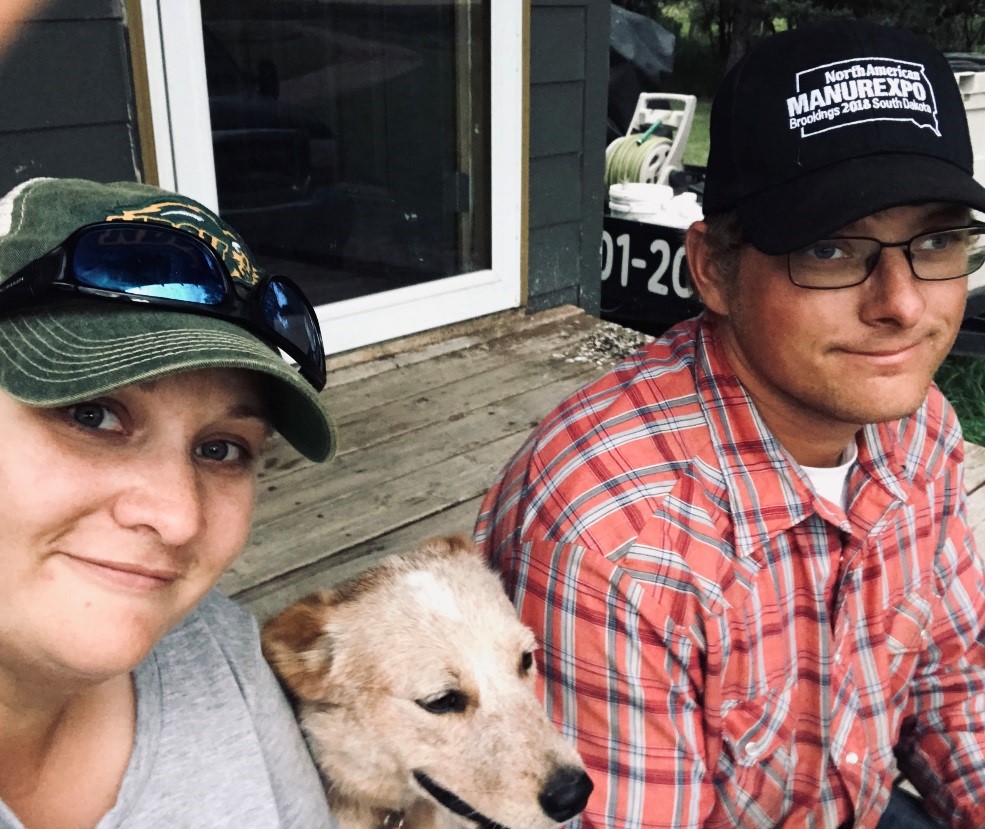 A lot of hard conversations occur on the steps at our farm. And Ruby Roo is almost always in on them!
A lot of hard conversations occur on the steps at our farm. And Ruby Roo is almost always in on them!
Mary Keena and the Carrington Research Extension Center Staff
NDSU.Carrington.REC1@ndsu.edu
701-652-2951
Soybean Yield Response to Phosphorus at Three Planting Dates
Objective
To determine whether phosphorus (P) fertilization has an impact on soybean yields at the CREC and if the yield response is affected by planting dates.
Method
Two soybean trials were conducted at the CREC in 2019, one under irrigation and the other under dryland conditions.
The three planting dates were:
- Early (May 11)
- Normal (May 24)
- Late (June 8)
The early planting date signifies a period from late April to mid-May, when less than 25% of soybean farms would have planted in North Dakota (ND).
The P treatments were 0 (also called control), 20 and 40 lbs P, applied and incorporated prior to planting.
The P soil test (Olsen) level under irrigation was medium (9 ppm = 18 lbs P/ac) and dryland was low (7 ppm = 14 lbs P/ac) based on P recommendation for soybean in ND.
Results
- Average yield was 66 bushels under irrigation (about 8 bushels less than average) and 62 bushels on dryland (at least 10 bushels greater than average) for the site.
- Yields were significantly improved by P application and planting dates under dryland. Planting before the end of May (May 11th or 24th) resulted in significantly greater yields than planting in June (Figure 1). Adequate late summer and fall rainfall with low average temperature likely explains why early planting did not produce better yields than normal planting date as we have seen in previous studies.
- Under irrigation, the effect of planting dates interacted with P rates. This means that significant effects of P on yields differed by planting dates. With early planting, 20 lbs of P improved yields by 3 bushels compared to the control, while yields were not different under normal planting date. Meanwhile, at late planting, 40 lbs P lowered yields by at least 3 bushels compared to either 0 or 20 lbs P (Figure 2).
- Compared to results from the previous two years (2017 and 2018), this was the first year that yields improved significantly from P application, and at early planting. This was likely due to better yields in 2019 under dryland and slower mineralization of soil organic P under irrigation, where the soil was relatively wetter and cooler for prolonged periods.
Conclusions
- Under medium to high soil test P levels, P application to soybean at the CREC is not likely to result in frequent improvement in yields, to cover the cost.
- Planting soybean early, between the first week to mid-May, is more likely to result in greater yields than planting later. Yield gained from P application at early planting supported the notion that P fertilization is more likely to impact yields when soils are cool and wet for prolonged periods.
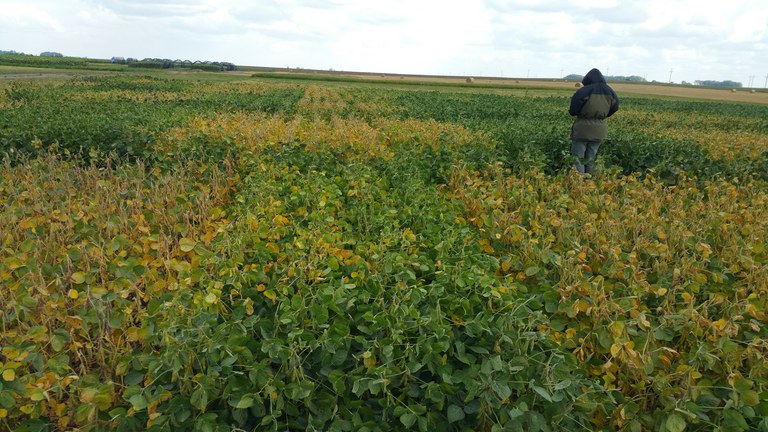
Soybean at three planting dates.
Acknowledgement
This research would not have been possible without funding from the North Dakota Soybean Council.
Jasper M Teboh, Ph. D.
Jasper.Teboh@ndsu.edu
Research Soil Scientist


